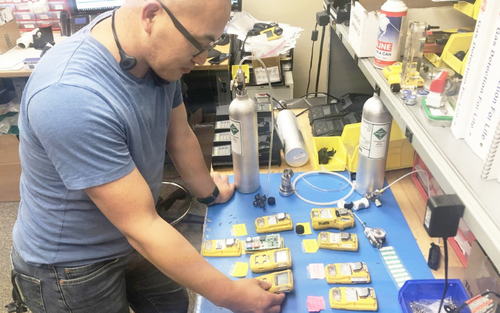Confined Space Gas Detector Requirements: How to Select a Gas Detection Kit for Your Confined Space
Confined spaces can pose a serious risk to the health and safety of your team. Whether you are repairing damaged equipment, building a new structure, or investigating a potential leak, you need to make sure your team can safely enter confined spaces on the job. Oxygen tends to be in short supply in confined spaces, including tunnels, crawl spaces, basements, manholes, and other tight areas.
To protect your team, you need to continuously monitor the space for hazardous gases using a gas detection kit. These kits are designed to detect a range of air-borne hazards. If the space were to become unsafe, the alarm will go off immediately, so you and your team can leave the area as quickly as possible.
Answer the following questions to choose the right type of confined space gas monitor for your business.
What Type of Gas Detection?
Confined spaces are not meant for human occupancy and many different types of hazards may be present. Research the area in question to make sure your team can identify and respond to any hazards they might encounter in the space, including chlorine gas, carbon monoxide, toxic air particles, flammable gases, and hydrogen sulfide.
It’s best to use a gas detection kit that will protect against a range of hazardous gases, including those mentioned above. Use a 4-gas monitor to protect your team from all types of airborne hazards.
What Types of Confined Spaces Will You Encounter?
You should also consider the different types of confined spaces you and your team will encounter on the job. If your business fields a range of requests and service calls, you and your team may have to contend with a series of different challenges. Therefore, it’s important to have a comprehensive, portable gas detection kit that will protect you and your team in all situations.
Consider all the different types of environments you may encounter on the job and the challenges they present. Will you need to lower your employees into the space, or can they walk in? Is there moisture in the space or do you tend to work in dry environments?
How Will You Sample the Air in the Confined Space?
Once you understand the types of environments and confined spaces you and your team may encounter on the job, you can start comparing different types of gas monitors.
Based on the nature of the space in question, you need to consider how you will sample the air inside the space. You will need to use these initial readings to get your team ready to enter the space. If hazardous gases are present, your team will need to wear the correct protective gear.
There are generally two types of confined space gas monitors: those that use diffusion and those that pump air out of the confined space. With diffusion, the gas monitor must be physically exposed to the air in question. The air will need to pass over the sensors on the monitor, which may present a challenge if you and your team do not have the right equipment to enter the space. Some teams may tie their monitor to a string and lower it down into the confined space, but this can easily damage the device if water is present in the space.
It’s generally best to find a confined space gas monitor with a sampling hose, so you can collect and sample the air in question before entering the space. You can collect a sample from several feet away without endangering the health and safety of your team.
Can You Continuously Monitor Space?
In addition to the initial reading, you need to continuously monitor the air inside the confined space while your team is inside. The device should alert you and your team immediately if a gas leak should occur. The alarm should be audible and visible to reduce the chances of your team missing the alarm. If you are wearing a portable monitor on your person, it should vibrate as well in case you can’t see or hear the initial alarm.
The kit in question should continue sampling and testing the air in the space as long as humans are present, so you are always aware of your surroundings.
Using Your Gas Detection Kit in the Field
Owning a confined space gas detection kit requires regular maintenance. You need to calibrate or bump test your equipment on a regular basis to make sure it is working properly. You also need to keep your equipment charged in the field.
Comprehensive gas detection kits come with all the gas detector accessories you need to use the device in the field, including a sampling hose, automatic recordkeeping, and instrument diagnostics. You can also plug individual gas monitors into the charging station, so they are fully charged and calibrated the next time you come into work. Find a confined space gas monitor with a durable carrying case, so your equipment does not get ruined in the field.
Keep these tips in mind when choosing a 4-gas monitor kit for your business.
Related Searches
Types Of Gas Detectors, Lel Gas, Catalytic Gas Detector, Rki Gx-6000 For Benzene Multi-Gas 72-6Azx-C, Gloves For Oil
Recent Posts
-
Customizing Gas Detectors: Tailoring Solutions to Fit Your Unique Requirements
In today’s diverse industrial landscape, a one-size-fits-all approach to safety simply doesn’t cu …Jul 3rd 2024 -
10 Ways to Prevent Wildfires
You can prevent wildfires by extinguishing flames before you leave the worksite. Avoid practicing …Jul 1st 2024 -
ANSI/ISEA 138 Safety Gloves: Ensuring Hand Protection
The human hand is an anatomical masterpiece and arguably the greatest tool attached to our bodies …Jun 25th 2024





